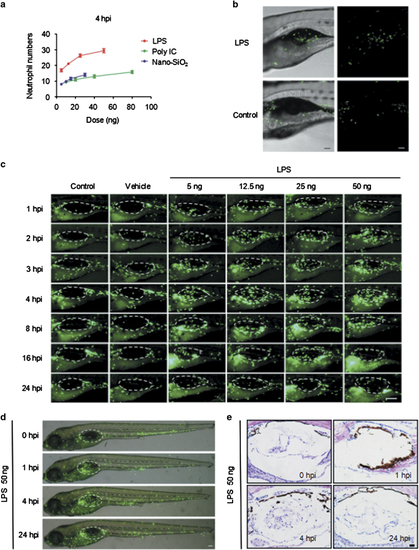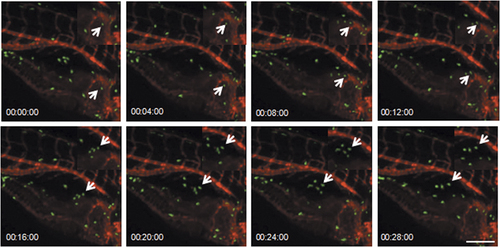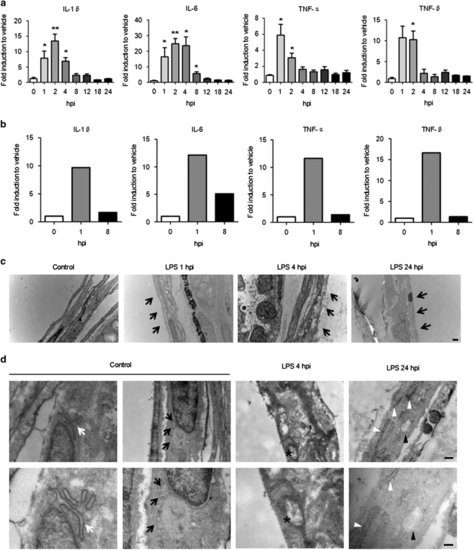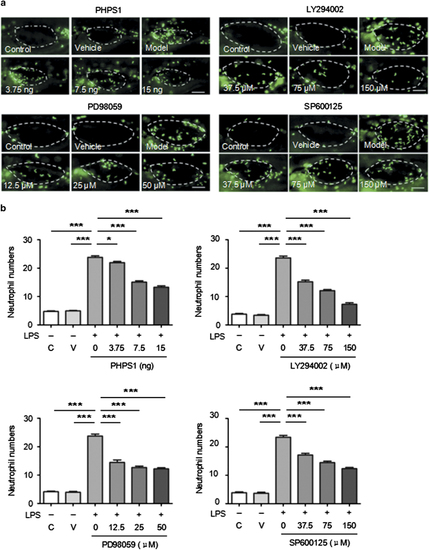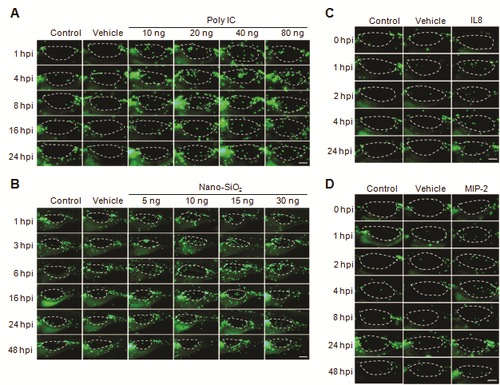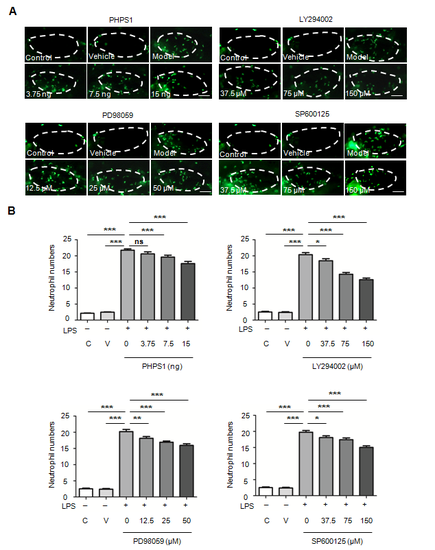- Title
-
Manipulating the air-filled zebrafish swim bladder as a neutrophilic inflammation model for acute lung injury
- Authors
- Zhang, Y., Liu, H., Yao, J., Huang, Y., Qin, S., Sun, Z., Xu, Y., Wan, S., Cheng, H., Li, C., Zhang, X., Ke, Y.
- Source
- Full text @ Cell Death Dis.
|
Neutrophils migrate into the LPS-injected zebrafish swim bladder. (a) The dose response for neutrophil recruitment into the swim bladder of 5-dpf zebrafish larvae after stimulation with LPS, Poly IC and Nano-SiO2 for 4 hpi. (b) Neutrophil accumulation into the Tg(mpo:GFP) zebrafish (5 dpf) swim bladder after the 50 ng LPS injection was imaged by confocal microscopy at 5 hpi (maximum projection slices n=66; green, neutrophil; scale bar: 60 μm). (c) Neutrophil recruitment to the LPS-injected swim bladder (indicated by the dotted line) of Tg(mpo:GFP) zebrafish larvae at 5 dpf was monitored (green, neutrophil; scale bar: 100 μm). (d) The neutrophil distribution (green) throughout the whole body (scale bar: 100 μm). (e) HE staining of zebrafish (5 dpf) swim bladders after the LPS challenge (scale bar: 20 μm) |
|
Neutrophils are recruited to the LPS-injected swim bladders in vivo. Neutrophils accumulate in the swim bladders of Tg(mpo:GFP/flk1:mCherry) zebrafish larva after the LPS (50 ng) injection (green, neutrophil; red, vessels; z-stack: 31 sections every 5 μm; scale bar: 70 μm; arrow indicates a neutrophil that is moving into the swim bladder; time is expressed as h:min:s starting at 40 min post injection; see Supplementary Movie S1). The magnification is presented in the top right corner of each image |
|
LPS induces inflammatory cytokine expression and injury in the zebrafish swim bladder. (a) Whole-body mRNA levels for IL-1β, IL-6, TNF-α and TNF-β increased after the 50-ng LPS injection. The results are presented as the mean±S.E.M.; n=30 in each group; *P<0.05; **P<0.01; (Student’s t-test); three independent experiments. (b) The changes to the mRNA levels for IL-1β, IL-6, TNF-α and TNF-β in the swim bladder after the 50-ng LPS injection. n=100 swim bladders per group. (c) Damaged epithelial layer in the swim bladder of LPS-injected (50 ng) zebrafish larvae at 5 dpf (indicated by black arrows). (d) Swollen ER (indicated by white arrowheads) and the control (indicated by white arrows). Mitochondrial injuries include mitochondrial cristae breakage (indicated by asterisks) and vacuolation (indicated by black arrowheads). The control mitochondria are indicated by black arrows. The lowers panels (scale bar: 0.25 μm) are magnifications of the upper panels (scale bar: 0.5 μm) |
|
Exogenous stimuli trigger neutrophil recruitment into zebrafish swim bladders. Neutrophil recruitment to exogenous materials [Poly IC (A), Nano-SiO2 (B), IL8 (1 ng) (C), MIP-2 (2 ng) (D)] that were injected into the swim bladders (indicated by dotted line) of Tg(mpo:GFP) zebrafish larvae at 5 dpf was monitored (green, neutrophil; scale bar: 100 μm). |
|
Injection of BALF from pneumonia patients induces neutrophil migration to the swim bladder. The swim bladders (indicated by dotted line) of Tg(mpo:GFP) zebrafish larvae were injected at 5 dpf with pneumonic BALF (1,2,3,4,5) or BALF from patients suffering from tracheal foreign bodies (Normal). Neutrophil recruitment to the injection site was examined (green, neutrophil; scale bar: 100 μm). |
|
Inhibitors affect neutrophil recruitment into the swim bladder after ALI is established. (A) PHPS1, LY294002, PD98059 and SP600125 inhibited neutrophil recruitment after LPS injection (dotted line indicates the swim bladder; scale bar: 100 μm). (B) The corresponding statistical graph (C, control; V, vehicle). The results are presented as the mean±s.e.m.; n=15 per group; *P<0.05; **P<0.01; ***P<0.001 (Student’s t-test). |

